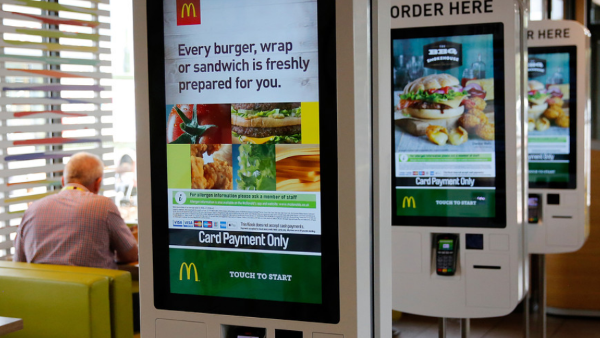What is Kiosk Mode, Features and How to Setup
1 What is Kiosk Mode?
Kiosk Mode is a feature that can transform any device into a dedicated terminal by restricting access to specific apps and customizing device functions.
- App/website Lockdown: Admins can enforce devices to run only specific apps, typically chosen from those available in the App Store or developed by the business. They can also select browsers like Chrome, Edge, and Kiosk browser for lockdown, allowing only specified websites while blocking all others.
- Device functions configuration: Admins can customize the general fucntions of the device such as microphone, camera, and Wi-Fi connection, VPN or hotspot for netwrok securty. Advanced functions, like Developer Mode, Credential can also be enabled or disabled.
[Quick View]
2 Applications of Kiosk Mode in Enterprise Environments
We’ve seen what is kiosk mode, but what is its use for businesses? Kiosk mode can serve a lot of purposes but it is mostly implemented for two applications in the business environment.
Kiosk Mode for Different Purposes
Self-service kiosks or digital signage(for Customers): Kiosk mode is utilized to configure a single app mode so that devices can be used as a self-service kiosk (a device that provides a service to the customers. For example, a tablet that allows them to order their meal inside a restaurant, or that allows them to buy a bus ticket in a square), and digital signage in public areas(screens that provide useful information to the public, like parking availability).
Purpose-built devices(for Employees): Kiosk mode can be used to restrict the number and/or types of applications that can run on mobile devices in use by employees within a company or organization. This would limit device access to the user and, other than increasing productivity and focus, it would also enhance security by limiting the risk of getting malware or losing data.
Use Cases for Kiosk Mode in Various Industries
Kiosk mode offers versatile applications across numerous industries and sectors. Let’s have a look at the main ones.
🍽️Food Sector
In restaurants, kiosk mode can be implemented on devices such as tablets to configure self-ordering kiosks or POS systems.

Benefits:
- This application of kiosk mode allows customers to place their own orders and make their payments without the need for staff intervention.
- This would speed up the service, enhancing customers’ satisfaction, and it would also reduce staff workload, allowing employees to focus on other, priority tasks such as food preparation.
🧑🎓Education
In educational settings, kiosk mode can be utilized to restrict students’ access to recreational apps on their devices.

Benefits:
- By locking out access to non-educational applications and websites, distraction is minimized and productivity is improved.
- This allows students to stay on task, while teachers can manage the learning process more efficiently.
- Furthermore, kiosk mode also enhances security as it prevents pupils from accessing adults’ content or other websites unsuitable for minors.
🚏Advertising and Public Digital Signage
In the advertising industry and public information sector, kiosk mode can be utilized to transform TVs into screens that only display the required content.

Benefits:
- Kiosk mode allows businesses and organizations to remotely manage and update the displayed content.
- This way, they can create an efficient management system that saves time and resources, ensuring consistent branding and messaging, and reducing costs.
🏢Office
Similarly to the use in the educational sector, in the office environment, the kiosk mode can be used to restrict devices to running only work-related applications.

Benefits:
- Other than enhancing productivity, kiosk mode can also enhance security by protecting the company’s data and reducing the risk of malware and cyber-attacks.
3 Kiosk Mode on Different Platforms: Setup Methods and Challenges
How can kiosk mode be implemented on different types of devices? In this paragraph, we’re providing a guide for each of the main operating systems available.
Windows 10/11
Method 1. Assigned Access
Windows’ Assigned Access feature is known as the simplest way to implement kiosk mode on a Windows device. Inside the Account Settings, then Family and Other People, users can select the Assigned Access option. Here, they can create a kiosk mode account that would run a single application on the device.
But it isn’t suitable for business and organizations becuase it only allows single-app mode and it doesn’t provide any further possibility of function personalization.
Method 2. Powershell
To configure the kiosk mode using the Powershell function, you can use the Set-AssignedAccess PowerShell cmdlet from the Windows terminal. Again, this is extremely complex and requires IT technology.
Method 3. Windows Configuration Designer
This tool allows IT administrators to create provisioning packages that can configure devices in bulk, including setting up kiosk mode. While it still requires technical expertise and knowledge of Windows provisioning.
Method 4. Shell Launcher
Configuring kiosk mode by replacing the default Windows shell (Explorer.exe) with a custom shell. This means you can launch a specific app or a custom shell experience when the user logs in, giving greater control over the device's behavior.
This method provides great control over the Windows device; however, it is requires familiarity with a lot of technical aspects such as Group Policy and, of course, PowerShell scripting.
Method 4. Third-party MDM Solution
Premium MDM solutions can provide advanced yet simpler ways to restrict a Windows account.
AirDroid Business, the most recommended on the market, allows administrators to easily lock devices into single or multiple apps, or lockdown custom Chrome/Edge browser. These operations can be done remotely, from any location, and on a fleet of devices.
Android
Android devices also provide a built-in tool to set up a kiosk mode. However, as we’re about to discover, MDM solutions provide more advanced feature while being more user-friendly.
Method 1: App Pinning
Some Android devices features App Pinning, a function that restricts them to single app mode.
The App Pinning feature allows you to select one application to restrict your device in to. This is a rather simple way to set up a kiosk mode and restrict a device to a single-purpose, but it would be only suitable for private use. On the contrary, it won’t be suitable in an enterprise environment because:
Exiting the kiosk mode is too simple (the user can enter a PIN and exit the kiosk mode)
It doesn’t allow multi-app mode
It doesn’t allow any other type of personalization
Method 2. MDM Solution
Unlike App Pinning, which only provides basic single-app restriction, AirDroid Business MDM Solution offers advanced features such as multi-app kiosk mode, other than remote monitor and control, website allowlists, kiosk browser and more.
Chrome OS
ChromeOS devices can also be turned into single-purpose devices through kiosk mode. Again, there are a couple of ways you can do it.
Method 1. Auto-launch
The Auto-launch feature on ChromeOS devices allows administrators to configure it to automatically launch a specific app when the device is turned on. This is rather simple to set up even though it doesn’t allow multi-app mode.
Method 2. Google Admin Console
It’s a cloud-based platform that allows admins to remotely configure multiple devices in bulk. Through the Google Admin Console, you can set up a kiosk mode that supports single-app or multiple-app environments, as well as restrict access to system features such as notifications.
iOS
Method 1. Guide Access
Guided Access is a quick and simple way to lock an iOS device to a single app. It can be configured from Settings, Accessibility, and then a triple tap on the home or side button while in the app to lock the device. This is only ideal, however, for short-term use cases.
Method 2. Single-app mode on iPad
It requires supervision through Apple Configurator. It’s mainly used for parent-control purposes or in educational settings but they are not ideal to set up self-service kiosks or digital signage devices.
Challenges
Limited Features - some methods only allow single-app mode and, with them, it is just too easy to remove or bypass.
Built-in features require manual set-up and don’t allow bulk configuration. They would make kiosk mode set up extremely time and energy-consuming.
Some methdos do not allow a lot of personalization of the kiosk mode.
Windows kiosk mode setup methods are most too complex and require deep knowledge.
💡MDM solutions can help overcome these challenges as they provide advanced features, ease of use, and great support.
4 Why we Recommend Configuring Kiosk Mode with an MDM Solution
Using an MDM solution is the best way to remotely set up multiple devices in kiosk mode at once. These are the main reasons why:
- Remote setup at bulk: MDM solutions allow admins to set up multiple devices at once streamlining configurations and making the team save a lot of time and energy.
- Configure kiosks freely according to your preferences: MDM solutions provide powerful customization options, allowing you to disable access to non work releated features, like the notification bar, turn devices into full-screen mode, disable screen time-out, control screen orientation, and even set devices to auto-launch specific apps after a reboot.
- Unbreakable: MDM solutions prevent users from exiting the assigned app or apps, ensuring a secure and controlled environment. Unlike other methods, with MDM solutions only admins can exit the kiosk. Even after a factory reset, the device would remain under the control of the organization.
5 Key Takeaway
Kiosk Mode transforms devices into endpoints dedicated to specific purpose, ideal for businesses and public use. While built-in features exist on Windows, Android, ChromeOS, and iOS, advanced MDM solutions like AirDroid Business provide superior remote management, advanced customization, and security.
FAQs






Leave a Reply.